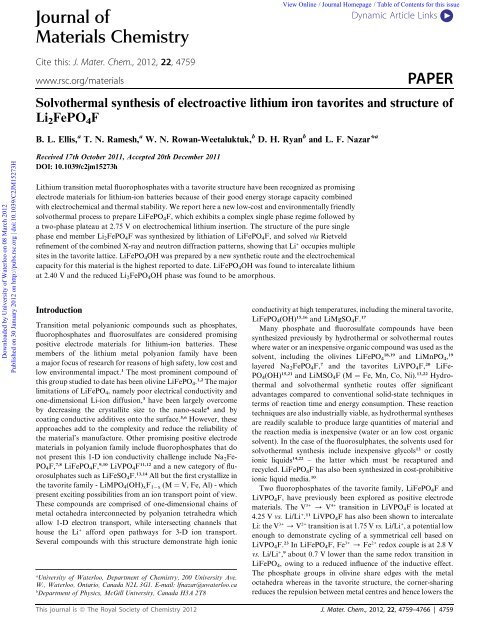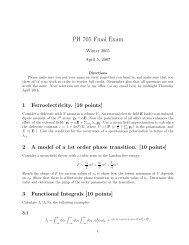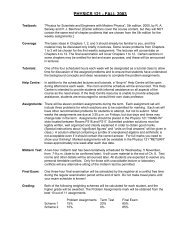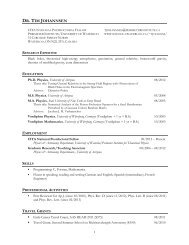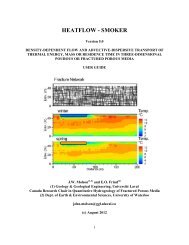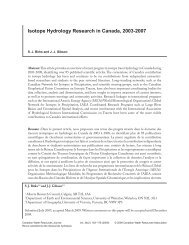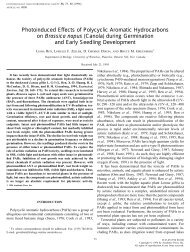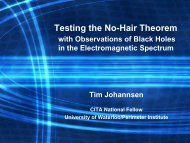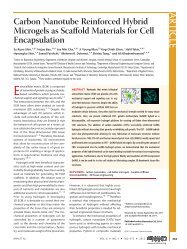J. Mater. Chem., 22, 4759-4766 (2012) - University of Waterloo
J. Mater. Chem., 22, 4759-4766 (2012) - University of Waterloo
J. Mater. Chem., 22, 4759-4766 (2012) - University of Waterloo
You also want an ePaper? Increase the reach of your titles
YUMPU automatically turns print PDFs into web optimized ePapers that Google loves.
Journal <strong>of</strong><br />
<strong>Mater</strong>ials <strong>Chem</strong>istry<br />
View Online / Journal Homepage / Table <strong>of</strong> Contents for this issue<br />
Dynamic Article Links C <<br />
Cite this: J. <strong>Mater</strong>. <strong>Chem</strong>., <strong>2012</strong>, <strong>22</strong>, <strong>4759</strong><br />
www.rsc.org/materials<br />
Solvothermal synthesis <strong>of</strong> electroactive lithium iron tavorites and structure <strong>of</strong><br />
Li 2 FePO 4 F<br />
B. L. Ellis, a T. N. Ramesh, a W. N. Rowan-Weetaluktuk, b D. H. Ryan b and L. F. Nazar* a<br />
PAPER<br />
Downloaded by <strong>University</strong> <strong>of</strong> <strong>Waterloo</strong> on 08 March <strong>2012</strong><br />
Published on 30 January <strong>2012</strong> on http://pubs.rsc.org | doi:10.1039/C2JM15273H<br />
Received 17th October 2011, Accepted 20th December 2011<br />
DOI: 10.1039/c2jm15273h<br />
Lithium transition metal fluorophosphates with a tavorite structure have been recognized as promising<br />
electrode materials for lithium-ion batteries because <strong>of</strong> their good energy storage capacity combined<br />
with electrochemical and thermal stability. We report here a new low-cost and environmentally friendly<br />
solvothermal process to prepare LiFePO 4 F, which exhibits a complex single phase regime followed by<br />
a two-phase plateau at 2.75 V on electrochemical lithium insertion. The structure <strong>of</strong> the pure single<br />
phase end member Li 2 FePO 4 F was synthesized by lithiation <strong>of</strong> LiFePO 4 F, and solved via Rietveld<br />
refinement <strong>of</strong> the combined X-ray and neutron diffraction patterns, showing that Li + occupies multiple<br />
sites in the tavorite lattice. LiFePO 4 OH was prepared by a new synthetic route and the electrochemical<br />
capacity for this material is the highest reported to date. LiFePO 4 OH was found to intercalate lithium<br />
at 2.40 V and the reduced Li 2 FePO 4 OH phase was found to be amorphous.<br />
Introduction<br />
Transition metal polyanionic compounds such as phosphates,<br />
fluorophosphates and fluorosulfates are considered promising<br />
positive electrode materials for lithium-ion batteries. These<br />
members <strong>of</strong> the lithium metal polyanion family have been<br />
a major focus <strong>of</strong> research for reasons <strong>of</strong> high safety, low cost and<br />
low environmental impact. 1 The most prominent compound <strong>of</strong><br />
this group studied to date has been olivine LiFePO 4 . 1,2 The major<br />
limitations <strong>of</strong> LiFePO 4 , namely poor electrical conductivity and<br />
one-dimensional Li-ion diffusion, 3 have been largely overcome<br />
by decreasing the crystallite size to the nano-scale 4 and by<br />
coating conductive additives onto the surface. 5,6 However, these<br />
approaches add to the complexity and reduce the reliability <strong>of</strong><br />
the material’s manufacture. Other promising positive electrode<br />
materials in polyanion family include fluorophosphates that do<br />
not present this 1-D ion conductivity challenge include Na 2 Fe-<br />
PO 4 F, 7,8 LiFePO 4 F, 9,10 LiVPO 4 F 11,12 and a new category <strong>of</strong> fluorosulphates<br />
such as LiFeSO 4 F. 13,14 All but the first crystallize in<br />
the tavorite family - LiMPO 4 (OH) x F 1 x (M ¼ V, Fe, Al) - which<br />
present exciting possibilities from an ion transport point <strong>of</strong> view.<br />
These compounds are comprised <strong>of</strong> one-dimensional chains <strong>of</strong><br />
metal octahedra interconnected by polyanion tetrahedra which<br />
allow 1-D electron transport, while intersecting channels that<br />
house the Li + afford open pathways for 3-D ion transport.<br />
Several compounds with this structure demonstrate high ionic<br />
a<br />
<strong>University</strong> <strong>of</strong> <strong>Waterloo</strong>, Department <strong>of</strong> <strong>Chem</strong>istry, 200 <strong>University</strong> Ave.<br />
W., <strong>Waterloo</strong>, Ontario, Canada N2L 3G1. E-mail: lfnazar@uwaterloo.ca<br />
b<br />
Department <strong>of</strong> Physics, McGill <strong>University</strong>, Canada H3A 2T8<br />
conductivity at high temperatures, including the mineral tavorite,<br />
LiFePO 4 (OH) 15,16 and LiMgSO 4 F. 17<br />
Many phosphate and fluorosulfate compounds have been<br />
synthesized previously by hydrothermal or solvothermal routes<br />
where water or an inexpensive organic compound was used as the<br />
18,19<br />
solvent, including the olivines LiFePO 4 and LiMnPO 4 , 19<br />
layered Na 2 FePO 4 F, 7 and the tavorites LiVPO 4 F, 20 LiFe-<br />
PO 4 (OH) 15,21 and LiMSO 4 F(M¼ Fe, Mn, Co, Ni). 13,<strong>22</strong> Hydrothermal<br />
and solvothermal synthetic routes <strong>of</strong>fer significant<br />
advantages compared to conventional solid-state techniques in<br />
terms <strong>of</strong> reaction time and energy consumption. These reaction<br />
techniques are also industrially viable, as hydrothermal syntheses<br />
are readily scalable to produce large quantities <strong>of</strong> material and<br />
the reaction media is inexpensive (water or an low cost organic<br />
solvent). In the case <strong>of</strong> the fluorosulphates, the solvents used for<br />
solvothermal synthesis include inexpensive glycols 13 or costly<br />
ionic liquids 14,<strong>22</strong> – the latter which must be recaptured and<br />
recycled. LiFePO 4 F has also been synthesized in cost-prohibitive<br />
ionic liquid media. 10<br />
Two fluorophosphates <strong>of</strong> the tavorite family, LiFePO 4 F and<br />
LiVPO 4 F, have previously been explored as positive electrode<br />
materials. The V 3+ / V 4+ transition in LiVPO 4 F is located at<br />
4.25 V vs. Li/Li + . 11 LiVPO 4 F has also been shown to intercalate<br />
Li: the V 3+ / V 2+ transition is at 1.75 V vs. Li/Li + , a potential low<br />
enough to demonstrate cycling <strong>of</strong> a symmetrical cell based on<br />
LiVPO 4 F. 23 In LiFePO 4 F, Fe 3+ / Fe 2+ redox couple is at 2.8 V<br />
vs. Li/Li + , 9 about 0.7 V lower than the same redox transition in<br />
LiFePO 4 , owing to a reduced influence <strong>of</strong> the inductive effect.<br />
The phosphate groups in olivine share edges with the metal<br />
octahedra whereas in the tavorite structure, the corner-sharing<br />
reduces the repulsion between metal centres and hence lowers the<br />
This journal is ª The Royal Society <strong>of</strong> <strong>Chem</strong>istry <strong>2012</strong> J. <strong>Mater</strong>. <strong>Chem</strong>., <strong>2012</strong>, <strong>22</strong>, <strong>4759</strong>–<strong>4766</strong> | <strong>4759</strong>
Downloaded by <strong>University</strong> <strong>of</strong> <strong>Waterloo</strong> on 08 March <strong>2012</strong><br />
Published on 30 January <strong>2012</strong> on http://pubs.rsc.org | doi:10.1039/C2JM15273H<br />
potential. Each <strong>of</strong> the electrochemical transitions reported in the<br />
tavorite fluorophosphates reported previously exhibit primarily<br />
two-phase behavior on both lithium intercalation and deintercalation,<br />
due to strong ion-electron interactions.<br />
Here, we report a new solvothermal synthesis <strong>of</strong> nanocrystalline<br />
iron tavorite LiFePO 4 F using ethanol as the solvent, and<br />
report its thermal stability compared to the hydroxy-tavorite,<br />
LiFePO 4 OH. We explore the nature <strong>of</strong> its complex single and<br />
two phase electrochemical behavior via measurements combined<br />
with ex-situ X-ray diffraction studies. Moreover, we report the<br />
first structural solution <strong>of</strong> the electrochemical end member,<br />
Li 2 FePO 4 F, based on a combined refinement <strong>of</strong> X-ray and<br />
neutron diffraction data. This follows on our previous iron<br />
tavorite report where only the lattice parameters <strong>of</strong> this phase<br />
were obtained by a LeBail fit <strong>of</strong> X-ray diffraction data. 9 The<br />
structure is revealed to be surprisingly complex; M€ossbauer<br />
spectroscopy was used to elucidate the structural subtleties and<br />
to verify the full reduction <strong>of</strong> Fe 3+ to Fe 2+ in Li 2 FePO 4 F.<br />
Furthermore, chemical reduction <strong>of</strong> LiFePO 4 OH to Li 2 Fe-<br />
PO 4 OH revealed a transition to an amorphous phase, which<br />
explained the change in electrochemical potential observed after<br />
the first discharge cycle <strong>of</strong> LiFePO 4 OH.<br />
Experimental<br />
LiFePO 4 OH<br />
In a typical synthesis, 1.78 g <strong>of</strong> an iron phosphate precursor<br />
(FePO 4 $1.5H 2 O, prepared as previously reported 24 ), was<br />
combined with 0.25 g LiOH$H 2 O and 0.10 g lithium acetate<br />
(Li(CH 3 COO) $2H 2 O) and 10 ml <strong>of</strong> deionized water in a 23 ml<br />
Teflon lined Parr acid digestion bomb. The mixture was stirred<br />
for 30 min and heated to 160–200 C for 8–15 h. The yellow<br />
product was filtered, washed with deionized water and dried<br />
under vacuum at 80 C for 16 h.<br />
LiFePO 4 F<br />
1.13 g <strong>of</strong> anhydrous FeF 3 and 1.04 g <strong>of</strong> LiH 2 PO 4 were stirred in<br />
15 ml <strong>of</strong> ethyl alcohol in a 23 ml Teflon lined Parr reactor. The<br />
mixture was heated to 230 C for 3 days. The light grey product<br />
was filtered, washed with deionized water and dried under<br />
vacuum at 80 C for 16 h. A solid-state method was also used to<br />
prepare LiFePO 4 F, as previously outlined. 9<br />
Li 1+x FePO 4 (F,OH)<br />
To intercalate Li into LiFePO 4 F, material prepared by the solidstate<br />
method was stirred with stoichiometric amounts <strong>of</strong> LiAlH 4<br />
for 44 h in tetrahydr<strong>of</strong>uran in an argon filled glove box and<br />
filtered to produce single phase Li 2 FePO 4 F. LiFePO 4 OH was<br />
reduced with stoichiometric amounts <strong>of</strong> n-butyl lithium.<br />
<strong>Mater</strong>ials characterization<br />
Powder X-ray diffraction was performed on a Bruker D8-<br />
Advance powder diffractometer using Cu-Ka radiation (l ¼<br />
1.5405 A), operating from 2Q ¼ 10 to 80 at a step size <strong>of</strong> 0.01 <br />
with a count time <strong>of</strong> 5 s per step. Neutron diffraction data was<br />
collected on a 3 g sample <strong>of</strong> Li 2 FePO 4 F using the HB2A High<br />
Resolution Powder Diffractometer at the High Flux Isotope<br />
Reactor at the Oak Ridge National Labs (Tennessee, USA).<br />
Samples <strong>of</strong> Li 1+x FePO 4 F were loaded in a hermetically sealed<br />
holder to prevent air exposure. Lattice parameters were initially<br />
determined using TOPASÔ s<strong>of</strong>tware and structural refinements<br />
were carried out with the GSAS program 25 with the EXPGUI<br />
interface 26 using full pattern matching. Scale factor, zero point,<br />
background, lattice parameters, atomic positions and thermal<br />
factors were iteratively refined.<br />
Powder samples for SEM were gold coated and examined in<br />
a LEO 1530 field emission scanning electron microscope<br />
(FESEM) equipped with an energy dispersive X-ray spectroscopy<br />
(EDX) attachment. Images were recorded at 15 kV with<br />
a back-scattered electron detector. For thermal gravimetric<br />
measurements, 10–20 mg samples were placed in an alumina<br />
crucible and heated at 10 C min 1 under air (100 mL min 1 )<br />
using a SDT Q-600 TGA from TA Instruments. A Bruker Tensor<br />
infrared spectrometer was used to collect spectra <strong>of</strong> as-prepared<br />
materials ground with KBr and pressed into pellets. Elemental<br />
analysis <strong>of</strong> Li 2 FePO 4 F was performed by inductively coupled<br />
plasma mass spectrometry.<br />
M€ossbauer spectra were collected over a counting time <strong>of</strong> 20 h<br />
in a hermetically sealed holder using a 50mCi 57 CoRh source<br />
mounted on a constant-acceleration spectrometer calibrated<br />
using a-Fe foil at room temperature. Fitting was accomplished<br />
using standard least-squares methods.<br />
For electrochemical measurements, materials were mixed with<br />
carbon black and polyvinylidene difluoride in a 75 : 15 : 10 weight<br />
ratio. The cell loading was 5–6 mg cm 2 . The electrochemical<br />
measurements were conducted in <strong>22</strong>20 coin cells, using a lithium<br />
metal anode and an electrolyte solution comprised <strong>of</strong> 1M LiPF 6 in<br />
1 : 1 ethylene carbonate/dimethyl carbonate. Room temperature<br />
galvanostatic cycling was performed between 1.5 and 4.0 V.<br />
Discussion<br />
View Online<br />
LiFePO 4 F prepared by solid state methods where the sample is<br />
heated under flowing argon produces a pure single phase material<br />
as we have previously reported, 9 in contrast to previous<br />
studies where the sintering environment was air. 12 The solvothermal<br />
technique reported here also produces single phase<br />
LiFePO 4 F - at a much lower temperature than the solid state or<br />
other solution-based methods - and without the need to recover<br />
expensive ionic liquids. 10 Precautions are necessary, however.<br />
The precursors were dried in an oven at 100 C and the ethanol<br />
was dried over molecular sieves prior to starting the reaction to<br />
minimize water and suppress OH formation in solution. X-ray<br />
diffraction patterns, indexed in P 1, and FESEM images <strong>of</strong><br />
LiFePO 4 F that compare the products from the solid state and<br />
solvothermal methods are shown in Fig. 1a and b. Reagent<br />
choice and pH control in the latter is critical in order to ensure<br />
LiFePO 4 F is the only product. For example, the addition <strong>of</strong><br />
NH 4 HF 2 which acts as both a fluorinating agent and a weak acid<br />
favored the formation <strong>of</strong> giniite, Fe 5 (PO 4 ) 4 (OH) 3 $2H 2 O, which<br />
precipitates in acidic media. 27 The solid-state prepared material<br />
forms agglomerates <strong>of</strong> large (300–1000 nm) particles typical <strong>of</strong><br />
carbon-free high-temperature synthesis routes. Conversely, the<br />
solvothermally produced LiFePO 4 F has a matchstick-like<br />
morphology: crystallites exhibit very small dimensions<br />
4760 | J. <strong>Mater</strong>. <strong>Chem</strong>., <strong>2012</strong>, <strong>22</strong>, <strong>4759</strong>–<strong>4766</strong> This journal is ª The Royal Society <strong>of</strong> <strong>Chem</strong>istry <strong>2012</strong>
View Online<br />
Downloaded by <strong>University</strong> <strong>of</strong> <strong>Waterloo</strong> on 08 March <strong>2012</strong><br />
Published on 30 January <strong>2012</strong> on http://pubs.rsc.org | doi:10.1039/C2JM15273H<br />
Fig. 1 (a–c) X-ray diffraction patterns and (d–f) corresponding SEM<br />
images <strong>of</strong> LiFePO 4 (OH) (a,d), LiFePO 4 F prepared by the solvothermal<br />
route (b,e) and LiFePO 4 F prepared by a solid-state route (c,f).<br />
(
View Online<br />
Downloaded by <strong>University</strong> <strong>of</strong> <strong>Waterloo</strong> on 08 March <strong>2012</strong><br />
Published on 30 January <strong>2012</strong> on http://pubs.rsc.org | doi:10.1039/C2JM15273H<br />
Fig. 4<br />
TGA curves <strong>of</strong> LiFePO 4 F, and LiFePO 4 (OH).<br />
the solid materials produced from this reaction were also formed<br />
on thermal decomposition <strong>of</strong> olivine LiFePO 4 under oxidizing<br />
conditions. 29 LiFePO 4 F is more stable in air than FeF 3 , which<br />
was found to hydrolyze at 450 C. 30 LiFePO 4 (OH) decomposes<br />
near 450 C, close to that reported for the decomposition <strong>of</strong><br />
LiFePO 4 (OH) under pure oxygen, 29 and at a significantly lower<br />
temperature than that we observed for LiFePO 4 F. X-ray<br />
diffraction identified both Li 3 Fe 2 (PO 4 ) 3 and Fe 2 O 3 as decomposition<br />
products <strong>of</strong> LiFePO 4 (OH). Clearly, the presence <strong>of</strong><br />
fluoride in the tavorite crystal structure increases the thermal<br />
stability <strong>of</strong> these compounds.<br />
Electrochemical pr<strong>of</strong>iles <strong>of</strong> as-prepared and pulverized<br />
samples <strong>of</strong> LiFePO 4 F cycled at a slow rate (C/50) are shown in<br />
Fig. 5. The initial discharge <strong>of</strong> the as-prepared sample features<br />
a short plateau at 2.75 V followed by a long sloping overcharge<br />
(Fig. 5a). Since the electrode is comprised <strong>of</strong> rather large particles<br />
<strong>of</strong> LiFePO 4 F which are not carbon-coated, the as-prepared<br />
material has a low capacity for Li intercalation (0.55 Li) as well<br />
as high polarization (0.25 V). These shortcomings are eradicated<br />
by pulverizing the as-synthesized material for 3 h in a planetary<br />
ball mill. Although even one hour <strong>of</strong> ball-milling was sufficient,<br />
more than 3 h was counterproductive. An SEM micrograph <strong>of</strong><br />
the active material after milling is shown in the inset <strong>of</strong> Fig. 5b.<br />
The particle morphology has changed significantly from the asprepared<br />
material (see Fig. 1). After milling, the particles have<br />
a spherical shape and range in size from 200–400 nm, and the<br />
carbon is better dispersed. For this material, the electrochemical<br />
pr<strong>of</strong>ile exhibits a sloping curve up to the insertion <strong>of</strong> 0.4 Li into<br />
the structure, at which point the pr<strong>of</strong>ile is flat. This plateau is also<br />
at 2.75 V vs. Li. The cell can reach full capacity (152 mAh/g) and<br />
the polarization <strong>of</strong> this cell is small (0.10 V). As we reported<br />
previously, little capacity fade on cycling was observed for this<br />
material. 9 The electrochemical pr<strong>of</strong>ile <strong>of</strong> the solvothermallyprepared<br />
LiFePO 4 F is shown in Fig. 5c. Although the material<br />
already has a very small particle size, milling with carbon (20–30<br />
min) was necessary to increase the conductivity <strong>of</strong> the electrode.<br />
The pr<strong>of</strong>ile has longer sloping regions but it still has a plateau at<br />
2.75 V for a small portion <strong>of</strong> the cycle. The capacity <strong>of</strong> this<br />
material is slightly lower as only 0.8 Li is intercalated on the first<br />
cycle although this may be due to insufficient dispersion <strong>of</strong> the<br />
conductive carbon black. Although grinding the carbon-free<br />
sample after preparation clearly reduces the primary particle size<br />
Fig. 5 Electrochemical data for LiFePO 4 F vs. Li/Li + collected in coin<br />
cells at a rate <strong>of</strong> C/50 for a) as-synthesized solid-state LiFePO 4 F; b) solidstate<br />
LiFePO 4 F ground in a ball mill for 3 h; solvothermal LiFePO 4 F<br />
ball-milled for 30 min. SEM images <strong>of</strong> prepared electrodes for each<br />
material are shown in the inset.<br />
<strong>of</strong> the electrode material, it is unclear whether the increase in<br />
electrode performance and change in pr<strong>of</strong>ile shape are strictly the<br />
result <strong>of</strong> particle size reduction or whether other factors, such as<br />
the change in particle shape or formation <strong>of</strong> an amorphous iron<br />
fluorophosphate phase, are responsible. However, regardless <strong>of</strong><br />
the method <strong>of</strong> sample preparation, LiFePO 4 F exhibited a flat<br />
voltage plateau at 2.75 V, indicative <strong>of</strong> a two-phase transition.<br />
4762 | J. <strong>Mater</strong>. <strong>Chem</strong>., <strong>2012</strong>, <strong>22</strong>, <strong>4759</strong>–<strong>4766</strong> This journal is ª The Royal Society <strong>of</strong> <strong>Chem</strong>istry <strong>2012</strong>
Downloaded by <strong>University</strong> <strong>of</strong> <strong>Waterloo</strong> on 08 March <strong>2012</strong><br />
Published on 30 January <strong>2012</strong> on http://pubs.rsc.org | doi:10.1039/C2JM15273H<br />
Electrochemical results for Li-ion cells based on the other<br />
anion composition, LiFePO 4 (OH), are presented in Fig. 6. The<br />
theoretical gravimetric capacity for insertion <strong>of</strong> 1 Li into LiFe-<br />
PO 4 (OH) is 154 mAh/g, slightly higher than that <strong>of</strong> LiFePO 4 F.<br />
As with LiFePO 4 F, the LiFePO 4 (OH) cells were prepared by<br />
ball-milling the as-prepared material for various lengths <strong>of</strong> time.<br />
The first discharge pr<strong>of</strong>iles <strong>of</strong> cells comprised <strong>of</strong> as-synthesized<br />
LiFePO 4 (OH), as well as material milled for 1–3 h are shown in<br />
Fig. 6a. Each LiFePO 4 (OH) cell has a flat plateau. However, the<br />
voltage <strong>of</strong> the as-prepared sample (2.30 V) is significantly lower<br />
than that <strong>of</strong> the sample milled for 1 h or milled for 3 h. This<br />
subtle increase in potential as a result <strong>of</strong> particle size reduction<br />
has also been reported for the olivine LiFePO 4 system. 31,32 The<br />
discharge capacity is also improved by decreasing the LiFe-<br />
PO 4 (OH) particle size. Full cycle pr<strong>of</strong>iles and SEM micrographs<br />
<strong>of</strong> the electrode material for the as-prepared and the 1 h milled<br />
samples prior to cycling are shown in Fig. 6b,c. By decreasing the<br />
particle size <strong>of</strong> the as-synthesized material and effectively<br />
dispersing the conductive carbon after milling for 1 h, the<br />
discharge capacity increased from 0.7 to 0.95 Li, both capacities<br />
being greater than those reported recently. 21 Initial cycling <strong>of</strong><br />
LiFePO 4 OH shows 5% capacity loss over the first ten cycles,<br />
although the electrochemical test conditions have not yet been<br />
optimized. Sharp capacity fade was observed for the sample ballmilled<br />
for 3 h. We note that subsequent discharge cycles for cells<br />
comprised <strong>of</strong> either as-prepared material or material milled for 1<br />
h exhibit a plateau at 2.42 V vs. Li. The potential <strong>of</strong> LiFe-<br />
PO 4 (OH) is roughly 0.35 V less than that <strong>of</strong> LiFePO 4 F, the result<br />
<strong>of</strong> the weaker electronegativity <strong>of</strong> the OH ion which decreases<br />
the influence <strong>of</strong> the inductive effect. 2<br />
View Online<br />
The origin <strong>of</strong> this increase in discharge voltage <strong>of</strong> 0.12 V, seen<br />
on the second cycle (see above) was examined by chemical lithiation<br />
<strong>of</strong> LiFePO 4 (OH) to produce Li 2 FePO 4 (OH), as outlined in<br />
Fig. 7. The Li 2 FePO 4 (OH) material was black in colour. Powder<br />
X-ray diffraction, performed in an air-sensitive holder sealed<br />
under argon, revealed no crystalline diffraction peaks, as shown<br />
in Fig. 7b. The amorphous Li 2 FePO 4 (OH) was chemically<br />
oxidized with NO 2 BF 4 in an attempt to regenerate LiFe-<br />
PO 4 (OH). Again, an X-ray diffraction pattern was collected in<br />
a sealed holder under argon, and the pattern (Fig. 7c) indicated<br />
the material remained amorphous on oxidation. Based on these<br />
results, the electrochemical pr<strong>of</strong>ile <strong>of</strong> LiFePO 4 (OH) may be<br />
explained: upon initial discharge, crystalline LiFePO 4 (OH)<br />
undergoes a transformation to an amorphous phase. The first<br />
charge cycle intercalates lithium ions into the amorphous structure<br />
and the second (and subsequent) charge and discharge cycles<br />
involve the (de)intercalation <strong>of</strong> lithium from this amorphous<br />
phase. Other positive electrode materials have been found to also<br />
undergo structural rearrangements to amorphous phases on the<br />
first electrochemical cycle, most notably the high-capacity silicate<br />
Li 2 MnSiO 4 . 33 Upon exposure to air (Fig. 7d), the tavorite phase<br />
recrystallized, as the pattern <strong>of</strong> LiFePO 4 OH was clearly<br />
recovered.<br />
To verify the two phase nature <strong>of</strong> the electrochemical reaction<br />
in LiFePO 4 F, we prepared variable compositions <strong>of</strong> Li 1+x Fe-<br />
PO 4 F (0 < x < 1) by chemical reduction <strong>of</strong> as-synthesized<br />
LiFePO 4 F with LiAlH 4 . Powder XRD patterns <strong>of</strong> these<br />
compositions are shown in Fig. 8; for clarity, the region <strong>of</strong> 2Q<br />
from 10–40 is highlighted and peaks <strong>of</strong> interest are indexed. On<br />
reduction to Li 1.25 FePO 4 F(x¼ 0.25 Li) a new second phase is<br />
barely evident in the diffraction pattern, signaled by the<br />
appearance <strong>of</strong> a very weak reflection at 2q ¼ 27.8 . This peak<br />
becomes unambiguously evident at the composition Li 1.5 Fe-<br />
PO 4 F. Subsequent reduction indicates continued growth <strong>of</strong> the<br />
new Li 2 FePO 4 F phase at the expense <strong>of</strong> LiFePO 4 F until<br />
complete intercalation <strong>of</strong> one equivalent <strong>of</strong> Li results, in accord<br />
with the electrochemical data. The stoichiometry <strong>of</strong> this phase<br />
was verified by elemental analysis which confirmed a Li:Fe:P<br />
Fig. 6 Electrochemical data for LiFePO 4 (OH) vs. Li/Li + (rate <strong>of</strong> C/50).<br />
a) Initial discharge curves for as-synthesized hydrothermal LiFePO 4 (OH)<br />
(blue), LiFePO 4 (OH) ground in a ball mill for 1 h (black) and LiFe-<br />
PO 4 (OH) ground in a ball mill for 3 h (red). The first two full cycles for<br />
cells <strong>of</strong> the as-prepared and 1 h milled samples are shown in b) and c)<br />
respectively, with SEM images <strong>of</strong> the materials shown in the insets. Initial<br />
cycling for the 1 h sample is also shown inset in c).<br />
Fig. 7 X-ray diffraction patterns <strong>of</strong> a) as-prepared LiFePO 4 OH; b)<br />
LiFePO 4 OH reduced with n-butyl lithium to make Li 2 FePO 4 OH; c) the<br />
chemical oxidation <strong>of</strong> Li 2 FePO 4 OH with NO 2 BF 4 to make LiFePO 4 OH;<br />
d) the material in c) exposed to air for 10 min at ambient conditions.<br />
This journal is ª The Royal Society <strong>of</strong> <strong>Chem</strong>istry <strong>2012</strong> J. <strong>Mater</strong>. <strong>Chem</strong>., <strong>2012</strong>, <strong>22</strong>, <strong>4759</strong>–<strong>4766</strong> | 4763
View Online<br />
Downloaded by <strong>University</strong> <strong>of</strong> <strong>Waterloo</strong> on 08 March <strong>2012</strong><br />
Published on 30 January <strong>2012</strong> on http://pubs.rsc.org | doi:10.1039/C2JM15273H<br />
Fig. 8 XRD patterns <strong>of</strong> Li 1+x FePO 4 F compositions prepared by<br />
chemical reduction with stoichiometric amounts <strong>of</strong> LiAlH 4 , showing the<br />
two-phase behavior upon LiFePO 4 F reduction. Selected peaks <strong>of</strong> LiFe-<br />
PO 4 F are shown with blue crosses and selected peaks <strong>of</strong> Li 2 FePO 4 F are<br />
shown with red asterisks.<br />
ratio <strong>of</strong> approximately 2 : 1 : 1, and EDX measurements which<br />
confirmed a Fe:P:F ratio <strong>of</strong> very close to 1 : 1 : 1. In short, the<br />
existence <strong>of</strong> a solid solution between 0 < x < 0.3 is unclear, but for<br />
x > 0.4, the existence <strong>of</strong> a two phase regime is unequivocal.<br />
M€ossbauer spectroscopy revealed very important clues about<br />
the lattice symmetry <strong>of</strong> LiFePO 4 F, and especially Li 2 FePO 4 F.<br />
The M€ossbauer spectrum for as-synthesized LiFePO 4 F is shown<br />
in Fig. 9a. The major signal (>90% <strong>of</strong> the total measured<br />
intensity) was fitted with a single isomer shift (IS) <strong>of</strong> 0.42(1) mm<br />
s 1 and quadrupole splitting (QS) <strong>of</strong> 1.15(1) mm s 1 , consistent<br />
with Fe 3+ in the presence <strong>of</strong> an octahedral field. Although there<br />
are two crystallographically unique Fe 3+ sites in LiFePO 4 F, the<br />
two sites are very similar, with two fluoride and four oxygen<br />
ligands <strong>of</strong> similar bond lengths co-ordinated to both unique Fe<br />
atoms, and thus it is difficult to resolve the two sites. The<br />
M€ossbauer spectrum and fit for the fully reduced material,<br />
Li 2 FePO 4 F are shown in Fig. 9b. Two distinct signals are clearly<br />
seen in the spectrum: the most prominent has parameters <strong>of</strong> IS ¼<br />
1.24 mm s 1 and QS ¼ 2.79 mm s 1 and the second signal has<br />
M€ossbauer parameters <strong>of</strong> IS ¼ 1.<strong>22</strong> mm s 1 and QS ¼ 2.18 mm<br />
s 1 . Together, these two signals make up about 90% <strong>of</strong> the total<br />
signal, which confirms the nearly full reduction <strong>of</strong> Fe 3+ to Fe 2+ in<br />
this sample. These two signals are in a (integrated) ratio <strong>of</strong><br />
2.9 : 1; ie close to 3 : 1. This is significant as LiFePO 4 F has only<br />
two unique Fe sites in the structure (Fig. 2). This unusual finding<br />
was also independently reported for a partially reduced sample<br />
without explanation. 10 It can be understood by structural effects.<br />
The structure <strong>of</strong> Li 2 FePO 4 F was elucidated by a combined<br />
Rietveld refinement <strong>of</strong> powder X-ray diffraction and neutron<br />
diffraction patterns. The fitted patterns are shown in Fig. 10a and<br />
b respectively and the refinement results are presented in Table 2.<br />
Indexing s<strong>of</strong>tware indicated the space group for Li 2 FePO 4 F was<br />
P 1, the same as that <strong>of</strong> LiFePO 4 F which was used as the starting<br />
point for the refinement. The final refined lattice parameters are<br />
similar to those reported previously from a LeBail fit. 9 There is<br />
an 8.0% volume expansion <strong>of</strong> the LiFePO 4 F lattice upon Li<br />
intercalation. The iron fluorophosphate framework <strong>of</strong> Li 2 Fe-<br />
PO 4 F is very similar to that in LiFePO 4 F: 1-D chains <strong>of</strong> cornershared<br />
FeO 4 F 2 octahedra connected by PO 4 tetrahedra.<br />
3<br />
Three<br />
Fig. 9 M€ossbauer spectra and fit (solid line) <strong>of</strong> a) LiFePO 4 F and b)<br />
Li 2 FePO 4 F, prepared from chemical reduction <strong>of</strong> LiFePO 4 F with<br />
LiAlH 4 .<br />
Fig. 10 Combined Rietveld refinement <strong>of</strong> X-ray and neutron powder<br />
diffraction data from a sample <strong>of</strong> Li 2 FePO 4 F. The statistical agreement<br />
factors for the combined refinement are: R wp ¼ 9.45%, R p ¼ 7.29%, c 2 ¼<br />
45.79. a) Refined X-ray diffraction pattern with agreement factors <strong>of</strong><br />
R wp ¼ 9.48%, R p ¼ 7.32%, R F2 ¼ 6.87%. b) Refined neutron diffraction<br />
pattern with agreement factors <strong>of</strong> R wp ¼ 6.40%, R p ¼ 4.95%, R F2 ¼<br />
6.83%. For each pattern, the collected data are in red, the fit is shown in<br />
black, the calculated reflections <strong>of</strong> Li 2 FePO 4 F are shown in blue, calculated<br />
reflections <strong>of</strong> Al are shown in green and the difference map is shown<br />
in grey. A summary <strong>of</strong> the refined data is given in Table 2 and a summary<br />
<strong>of</strong> Fe co-ordination environments is given in Table 3.<br />
4764 | J. <strong>Mater</strong>. <strong>Chem</strong>., <strong>2012</strong>, <strong>22</strong>, <strong>4759</strong>–<strong>4766</strong> This journal is ª The Royal Society <strong>of</strong> <strong>Chem</strong>istry <strong>2012</strong>
Table 2 Lattice constants and atomic parameters <strong>of</strong> Li 2 FePO 4 F determined by a combined refinement <strong>of</strong> X-ray and neutron powder diffraction data.<br />
Agreement factors for neutron diffractrion data: R wp ¼ 6.40%, R p ¼ 4.95%, R F2 ¼ 6.83% Agreement factors for X-ray diffraction data: R wp ¼ 9.48%,<br />
R p ¼ 7.32%, R F2 ¼ 6.87% Agreement factors for combined refinement: R wp ¼ 9.45%, R p ¼ 7.29%, c 2 ¼ 45.79<br />
Li 2 FePO 4 F<br />
View Online<br />
Downloaded by <strong>University</strong> <strong>of</strong> <strong>Waterloo</strong> on 08 March <strong>2012</strong><br />
Published on 30 January <strong>2012</strong> on http://pubs.rsc.org | doi:10.1039/C2JM15273H<br />
Space group: P 1 (#2), Triclinic<br />
M w ¼ 183.70 g mol 1<br />
D ¼ 3.<strong>22</strong>5 g cm 3<br />
a ¼ 5.3736(2) A<br />
b ¼ 7.4791(2) A<br />
c ¼ 5.3276(2) A<br />
a ¼ 108.398(4) <br />
b ¼ 94.615(4) <br />
g ¼ 108.217(4) <br />
V ¼ 189.142(8) A 3<br />
Atom Wych. x/a y/b z/c Occ. U iso<br />
Fe (1) 1a 0 0 0 1.0 0.011(2)<br />
Fe (2) 1b 0 1/2 0 1.0 0.008(1)<br />
P 2i 0.6389(9) 0.750(1) 0.348(1) 1.0 0.011(1)<br />
O (1) 2i 0.657(2) 0.866(2) 0.147(2) 1.0 0.015(3)<br />
O (2) 2i 0.335(2) 0.635(1) 0.309(2) 1.0 0.018(3)<br />
O (3) 2i 0.790(2) 0.620(2) 0.304(2) 1.0 0.012(3)<br />
O (4) 2i 0.278(2) 0.097(2) 0.365(2) 1.0 0.017(3)<br />
F 2i 0.888(1) 0.262(2) 0.171(2) 1.0 0.013(2)<br />
Li (1) 2i 0.465(5) 0.679(4) 0.743(5) 1.0 0.015<br />
Li (2) 1g 0 1/2 1/2 1.0 0.015<br />
Li (3) 2i 0.112(5) 0.824(7) 0.521(8) 0.5 0.015<br />
Table 3 Summary <strong>of</strong> Bond Distances for Each Iron Environment in<br />
Li 2 FePO 4 F<br />
Atom Ligand Multiplicity Distance ( A)<br />
Fe1 O2 2 2.0739<br />
O3 2 2.1372<br />
F1 2 2.1919<br />
Li2 2 2.6638<br />
Fe2A O4 2 2.1251<br />
O1 2 2.1408<br />
F1 2 2.1718<br />
Li3 2 2.6872<br />
Fe2B O4 2 2.1251<br />
O1 2 2.1408<br />
F1 2 2.1718<br />
site is a general position which is half occupied and octahedrally<br />
coordinated by one fluorine and five oxygen ligands.<br />
With the intercalated Li ions occupying these two sites, the<br />
M€ossbauer results can be put into structural context. Fig. 11b is<br />
a graphical representation <strong>of</strong> the bonding environment <strong>of</strong> the Fe1<br />
ion. The Fe–O and Fe–F bond distances range from 2.07 to 2.19<br />
A (see Table 3). Li2 resides between adjacent chains <strong>of</strong> Fe<br />
octahedra and each Fe1 shares triangular faces with two Li2 ions<br />
which are 2.66 A from Fe1. These Li + ions are close enough to the<br />
crystallographically unique Li sites were identified in Li 2 FePO 4 F.<br />
A graphical representation <strong>of</strong> the structure is shown in Fig. 11a.<br />
Li1 is positioned close to the centroid <strong>of</strong> the split Li position in<br />
the parent LiFePO 4 F. The new environment for this Li ion is<br />
smaller than that in LiFePO 4 F, owing to the significantly larger<br />
size <strong>of</strong> the Fe 2+ ion (78 pm radius, compared to Fe 3+ with a radius<br />
<strong>of</strong> 64 pm) 34 which forces atoms closer to Li1. As a consequence,<br />
the new Li position is not split. The two sites where the intercalated<br />
Li reside are Li2 and Li3, each <strong>of</strong> which is occupied by 0.5<br />
Li. Li2 resides between the chains <strong>of</strong> Fe octahedra on a special<br />
position, the 1g site and is coordinated by two fluorine and four<br />
oxygen ligands. A previous study <strong>of</strong> a natural (slightly reduced)<br />
sample <strong>of</strong> LiFePO 4 (OH) showed this site is partially occupied by<br />
Fe 2+ ions. 35 The electrochemical and powder XRD data (vide<br />
supra) suggest that occupation <strong>of</strong> this site does not induce a twophase<br />
transition until full insertion is achieved at x ¼ 0.5. The Li3<br />
Fig. 11 a) Graphical representation <strong>of</strong> the structure <strong>of</strong> Li 2 FePO 4 F with<br />
iron environments Fe1, Fe2A and Fe2B highlighted (b, c, d respectively).<br />
Phosphate tetrahedra are depicted in yellow, iron octahedra in blue, Li1<br />
in white, Li2 in green and Li3 in orange.<br />
This journal is ª The Royal Society <strong>of</strong> <strong>Chem</strong>istry <strong>2012</strong> J. <strong>Mater</strong>. <strong>Chem</strong>., <strong>2012</strong>, <strong>22</strong>, <strong>4759</strong>–<strong>4766</strong> | 4765
Downloaded by <strong>University</strong> <strong>of</strong> <strong>Waterloo</strong> on 08 March <strong>2012</strong><br />
Published on 30 January <strong>2012</strong> on http://pubs.rsc.org | doi:10.1039/C2JM15273H<br />
Fe1 site that the Li can be considered part <strong>of</strong> the Fe bonding<br />
environment. Representations <strong>of</strong> the Fe2 site are shown in<br />
Fig. 11c–d. The Fe–O and Fe–F bonds range from 2.12 to 2.17 A<br />
in length and the Li3 ion is also in close proximity to Fe2 (2.68<br />
A). If the Li3 site were fully occupied, each Fe2 ion would be<br />
face-shared with two Li octahedra, just as the case <strong>of</strong> the Fe1 site.<br />
As the Li3 site is only half occupied, only half <strong>of</strong> the Fe ions on<br />
the Fe2 site will face-share with two Li3 ions (denoted as the<br />
Fe2A site, see Fig. 11c). The remaining Fe2 sites (denoted as<br />
Fe2B sites, Fig. 11d) will not have any cations in the local<br />
environment. The similar environments <strong>of</strong> the Fe1 and Fe2A<br />
atoms can not be resolved by M€ossbauer spectroscopy and<br />
therefore, the ratio <strong>of</strong> [Fe1 + Fe2A] sites to the Fe2B sites in<br />
Li 2 FePO 4 F is 3 : 1, which is in accord with the M€ossbauer data.<br />
Finally, we note that the tavorite-type structure <strong>of</strong> Li 2 FePO 4 F<br />
prepared by reduction <strong>of</strong> LiFePO 4 F differs greatly from Li 2 Fe-<br />
PO 4 F prepared by ion-exchange <strong>of</strong> two-dimensional<br />
Na 2 FePO 4 F. 36<br />
Conclusions<br />
Simple and environmentally friendly hydro- and solvothermal<br />
methods provide easy routes to the synthesis <strong>of</strong> LiFe-<br />
PO 4 F 1 x (OH) x , although careful manipulation <strong>of</strong> the pH,<br />
precursors and solvent are necessary to produce pure tavoritetype<br />
phases. The higher electronegativity <strong>of</strong> F compared to<br />
OH serves to increase the thermal stability <strong>of</strong> LiFePO 4 F<br />
compared to LiFePO 4 (OH), and also raise the electrode potential<br />
from 2.40 V for LiFePO 4 (OH), to 2.75 V for LiFePO 4 F, as<br />
a consequence <strong>of</strong> the enhanced inductive effect. Both LiFe-<br />
PO 4 (OH) and LiFePO 4 F demonstrate two-phase behavior in Li<br />
cells, although particle size has a significant effect on the capacity<br />
and in the case <strong>of</strong> LiFePO 4 (OH), the potential itself. The twophase<br />
nature <strong>of</strong> LiFePO 4 F intercalation was confirmed by<br />
chemical reduction <strong>of</strong> LiFePO 4 F where Li 1+x FePO 4 F compositions<br />
clearly show a mixture <strong>of</strong> LiFePO 4 F and Li 2 FePO 4 F. The<br />
refined structure <strong>of</strong> Li 2 FePO 4 F shows that the corner-shared<br />
framework <strong>of</strong> the ‘‘FePO 4 F’’ lattice remains intact upon reduction<br />
to Li 2 FePO 4 F. Lithium insertion in the lattice is complex,<br />
and two sites are occupied. Occupation <strong>of</strong> the first appears to<br />
occur via a solid solution process (with respect to lithium<br />
concentration), whereas occupation <strong>of</strong> the last site triggers twophase<br />
behavior. The overall 8.0% volume expansion <strong>of</strong> the lattice<br />
upon insertion <strong>of</strong> one Li is a likely origin <strong>of</strong> the two-phase nature<br />
<strong>of</strong> this compound.<br />
Acknowledgements<br />
LFN and DHR acknowledge the generous financial support <strong>of</strong><br />
the NSERC through its Discovery, and Collaborative Research<br />
Development programs. Additional support was provided by<br />
NSERC through a Canada Research Chair (to LFN) and by<br />
FQRNT (Fonds Quebecois de la Recherche sur la Nature et les<br />
Technologies, to DHR). We thank the Oakridge National<br />
Laboratory for providing neutron beam time, and we are especially<br />
grateful to Dr. Ovidiu Garlea at ORNL for his acquisition<br />
<strong>of</strong> the powder neutron diffraction data.<br />
References<br />
View Online<br />
1 A. K. Pahdi, K. S. Nanjundaswamy and J. B. Goodenough,<br />
J. Electrochem. Soc., 1997, 144, 1188–1194.<br />
2 A. K. Pahdi, K. S. Nanjundaswamy, C. Masquelier, S. Okada and<br />
J. B. Goodenough, J. Electrochem. Soc., 1997, 144, 1609–1613.<br />
3 J. Li, W. Yao, S. Martin and D. Vaknin, Sol. Stat. Ion, 2008, 179,<br />
2016–2019.<br />
4 M. Gaberscek, R. Dominko and J. Jamnik, Electrochem. Commun.,<br />
2007, 9, 2778–2873.<br />
5 H. Huang, S. C. Yin and L. F. Nazar, Electrochem. Solid-State Lett.,<br />
2001, 4, A170–A172.<br />
6 P. S. Herle, B. Ellis, N. Coombs and L. F. Nazar, Nat. <strong>Mater</strong>., 2004, 3,<br />
147–152.<br />
7 B. L. Ellis, W. R. M. Makahnouk, W. N. Rowan-Weetaluktuk,<br />
D. H. Ryan and L. F. Nazar, <strong>Chem</strong>. <strong>Mater</strong>., 2010, <strong>22</strong>, 1059–1070.<br />
8 N. Recham, J.-N. Chotard, L. Dupont, K. Djellab, M. Armand and<br />
J.-M. Tarascon, J. Electrochem. Soc., 2009, 156, A993–A999.<br />
9 T. N. Ramesh, K. T. Lee, B. L. Ellis and L. F. Nazar, Electrochem.<br />
Solid-State Lett., 2010, 13, A43–A47.<br />
10 N. Recham, J.-N. Chotard, J.-C. Jumas, L. Laffont, M. Armand and<br />
J.-M. Tarascon, <strong>Chem</strong>. <strong>Mater</strong>., 2010, <strong>22</strong>, 1142–1148.<br />
11 J. Barker, M. Y. Saidi and J. L. Swoyer, J. Electrochem. Soc., 2003,<br />
150, A1394–A1398.<br />
12 J. Barker, R. K. B. Gover, P. Burns, A. Bryan, M. Y. Saidi and<br />
J. L. Swoyer, J. Power Sources, 2005, 146, 516–520.<br />
13 R. Tripathi, T. N. Ramesh, B. L. Ellis and L. F. Nazar, Angew.<br />
<strong>Chem</strong>., Int. Ed., 2010, 49, 8738–8742.<br />
14 N. Recham, J.-N. Chotard, L. Dupont, C. Delacourt, W. Walker,<br />
M. Armand and J.-M. Tarascon, Nat. <strong>Mater</strong>., 2010, 9, 68–74.<br />
15 M. S. Whittingham, Y. Song, S. Lutta, P. Y. Zavalij and<br />
N. A. Chernova, J. <strong>Mater</strong>. <strong>Chem</strong>., 2005, 15, 3362–3379.<br />
16 L. Sebastian and J. Gopalakrishnan, J. <strong>Mater</strong>. <strong>Chem</strong>., 2003, 13, 433–<br />
441.<br />
17 L. Sebastian, J. Gopalakrishnan and Y. Piffard, J. <strong>Mater</strong>. <strong>Chem</strong>.,<br />
2002, 12, 374–377.<br />
18 S. Yang, P. Y. Zavalij and M. S. Whittingham, Electrochem.<br />
Commun., 2001, 3, 505–508.<br />
19 B. Ellis, W. H. Kan, W. R. M. Makahnouk and L. F. Nazar, J. <strong>Mater</strong>.<br />
<strong>Chem</strong>., 2007, 17, 3248–3254.<br />
20 J. Barker, M. Y. Saidi and J. L. Swoyer, J. Electrochem. Soc., 2004,<br />
151, A1670–A1677.<br />
21 N. Marx, L. Croguennec, D. Carlier, A. Wattiaux, F. Le Cras,<br />
E. Suard and C. Delmas, Dalton Trans., 2010, 39, 5108–5116.<br />
<strong>22</strong> P. Barpanda, J.-N. Chotard, N. Recham, C. Delacourt, M. Ati,<br />
L. Dupont, M. Armand and J.-M. Tarascon, Inorg. <strong>Chem</strong>., 2010,<br />
49, 7401–7413.<br />
23 J. Barker, R. K. B. Gover, P. Burns and A. Bryan, Electrochem. Solid-<br />
State Lett., 2005, 8, A285–A287.<br />
24 P. P. Prosini, M. Carewska, S. Scaccia, P. Wisniewski, S. Passerini<br />
and M. Pasquali, J. Electrochem. Soc., 2002, 149, A886–A890.<br />
25 A. C. Larson and R. B. Von Dreele, Los Alamos National Laboratory<br />
Report LAUR 86-748, 2000.<br />
26 B. H. Toby, J. Appl. Crystallogr., 2001, 34, 210–213.<br />
27 T. Roncal-Herrero, J. D. Rodriguez-Blanco, L. G. Benning and<br />
E. H. Oelkers, Cryst. Growth Des., 2009, 9, 5197–5205.<br />
28 J. L. Pizzaro-Sanz, J. M. Dance, G. Villeneuve and M. I. Arriortua-<br />
Marcaida, <strong>Mater</strong>. Lett., 1994, 18, 327–330.<br />
29 S. Yang, P. Y. Zavalij and M. S. Whittingham, Electrochem.<br />
Commun., 2001, 3, 505–508.<br />
30 L. Domange, Ann. Chim., 1937, 7, 235–297.<br />
31 N. Meethong, H.-Y. S. Huang, W. C. Carter and Y.-M. Chiang,<br />
Electrochem. Solid-State Lett., 2007, 10, A134–A138.<br />
32 K. T. Lee, W. H. Kan and L. F. Nazar, J. Am. <strong>Chem</strong>. Soc., 2009, 131,<br />
6044–6045.<br />
33 R. Dominko, J. Power Sources, 2008, 184, 462–468.<br />
34 R. D. Shannon, Acta Crystallogr., Sect. A: Cryst. Phys., Diffr., Theor.<br />
Gen. Crystallogr., 1976, A32, 751–767.<br />
35 O. V. Yakubovich and V. S. Urusov, Geokhimiya, 1997, 7, 720–729.<br />
36 B. Ellis, W. R. M. Makahnouk, Y. Makimura, K. Toghill and<br />
L. F. Nazar, Nat. <strong>Mater</strong>., 2007, 6, 749–753.<br />
<strong>4766</strong> | J. <strong>Mater</strong>. <strong>Chem</strong>., <strong>2012</strong>, <strong>22</strong>, <strong>4759</strong>–<strong>4766</strong> This journal is ª The Royal Society <strong>of</strong> <strong>Chem</strong>istry <strong>2012</strong>


